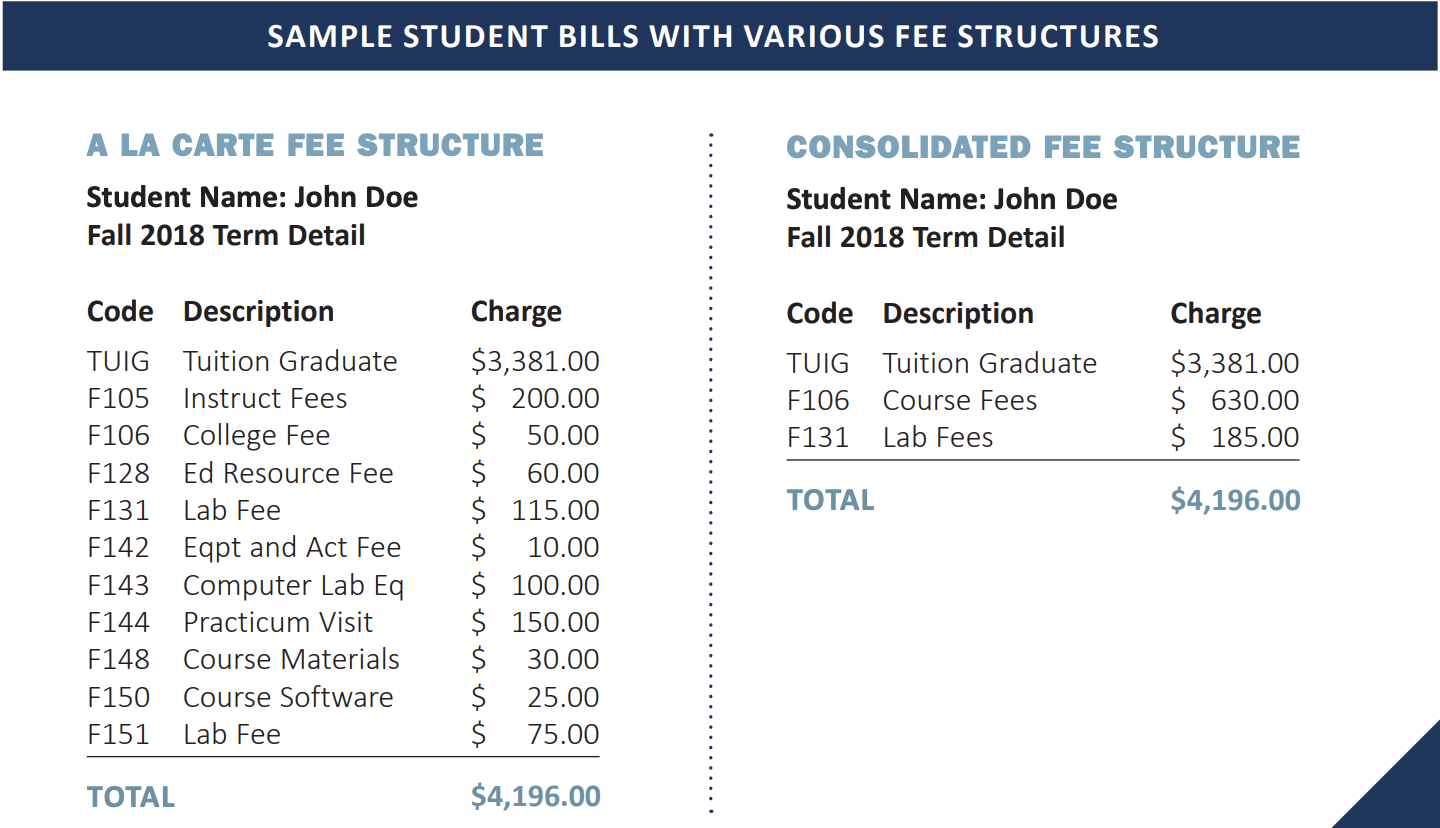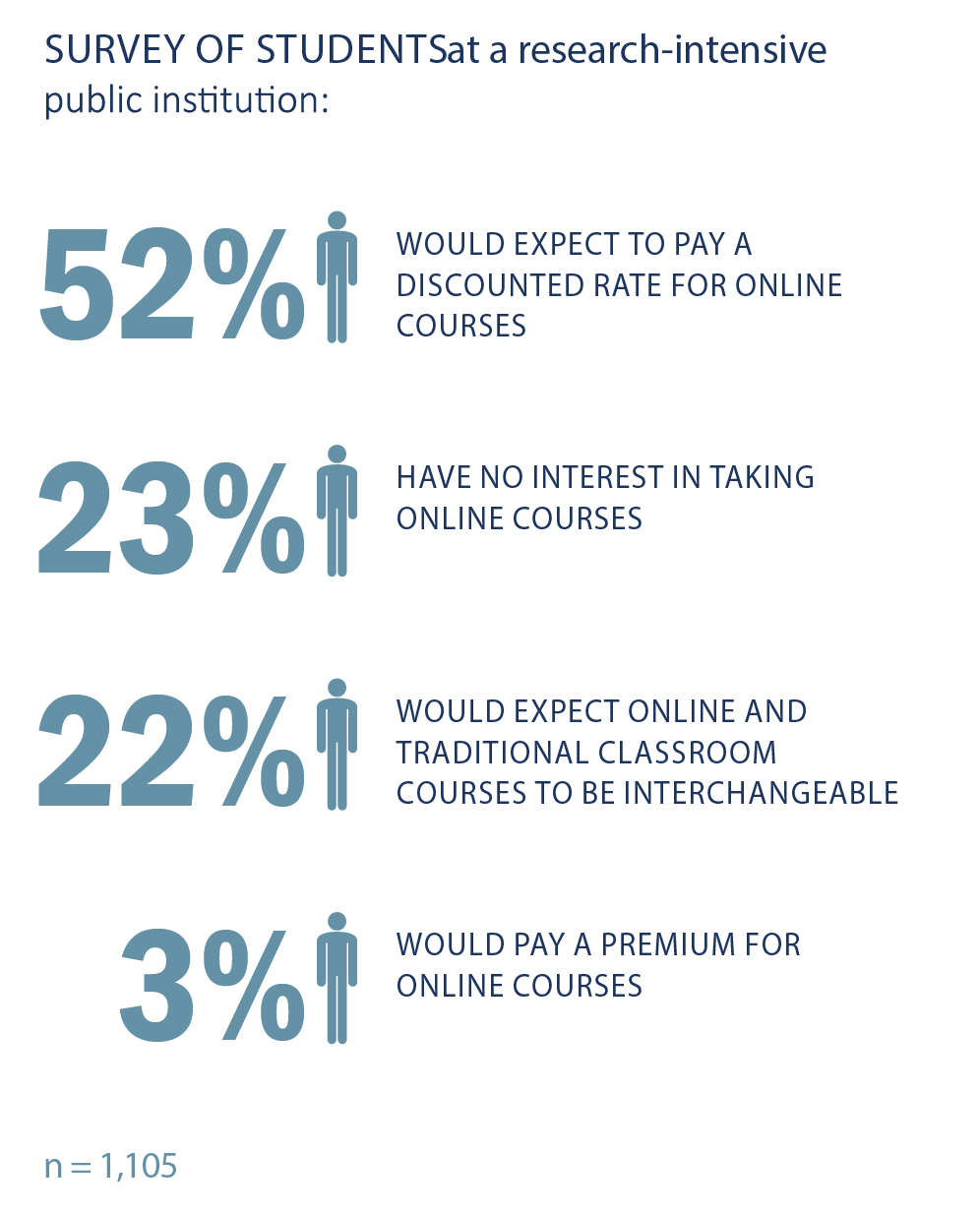A Major Impact on Student Success
In an age of rapidly-increasing college costs, institutions have been confronted with questions about tuition and fees that seem simple but are often much more complex. Answers to important questions from students such as “How much will it cost for me to attend this university?” are often not transparently or effectively answered by most institutions. A recent study by the University of Pennsylvania discovered that nearly 75% of institutions’ websites do not provide an adequate overview of the net price students would be expected to pay.1 The proliferation of fees levied at the university, academic program, and/or course level can add up quickly, which leads to confusion in both the quantity of lines on a Bursar’s bill and the total dollar amount of those fees, and leaves current students—as well as prospective students and their parents—feeling “nickel-and-dimed.”Certain subsets of student populations such as Pell, post-Pell, and first-generation college students are particularly impacted by these pricing issues, which can result in lower enrollment and retention rates, as well as reduced course consumption and longer time to completion for these and other groups of students.
 Nearly 75% of institutions’ websites do not provide an adequate overview of the net price students would be expected to pay
Nearly 75% of institutions’ websites do not provide an adequate overview of the net price students would be expected to pay
Further complicating this lack of transparency is the greater attention being paid to tuition pricing from local and national policymakers. After nearly 20 years of tuition costs increasing at rates above the consumer price index (CPI), legislatures in states throughout the nation have begun to place greater emphasis in their funding decisions for public institutions on the fully-bundled cost of education by factoring in all mandatory fees. Politicians, media organizations, and higher education watchdogs are beginning to realize that some universities and specific academic programs have used fee increases to help fund budget gaps or strategic priorities. All of these factors together have led universities to take a hard look at how much—and in what format—they charge tuition and fees.

While all of these questions challenge universities, agile institutions have begun to creatively modify their tuition and fee pricing to proactively ameliorate these concerns. As universities consider redesigning their budget models and making key resource allocation decisions, they can use these efforts as an opportunity to revisit their pricing structures. Modernizing tuition and fee structures can help universities:
- Match demand for academic programs
- Incentivize new course-taking patterns
- Generate additional net tuition revenue
University of Pennsylvania Scholarly Commons https://repository.upenn.edu/cgi/ viewcontent.cgi?article=1004&context=ahead_papers
Guiding Principles of Tuition and Fee Pricing Structure Modifications
Kennedy & Company’s experience in assisting universities with tuition and fee simplification initiatives has led to an identification of three guiding principles for all such initiatives:
Reduce confusion for students
Institutions should clearly and articulately communicate the cost of attending each academic program by showing only one price as early as possible, with limited jargon, add-ons, or customizations. Students and parents oftentimes feel “blindsided” by course and program fees and do not adequately plan for them. The messaging of tuition and fee pricing must be clearly communicated to current and prospective students up-front.
Limit the burden on financial systems and personnel
Complex or highly-customized tuition and fee structures impose a burden on financial systems and the personnel operating them, leading to human error risk. A high number of course and program fees leads to an intensive review and adjudication process annually. Aggregating fees streamlines this effort and ensures that all new and increased fees are considered consistently.
Remain revenue neutral or positive
Academic units offering general education courses can be adversely impacted by streamlining pricing structures, so institutions must develop a solution to this issue by gathering broad-based buy-in from the academic units. Expensive or other “one-off” courses should be factored out of aggregate course fees to ensure that only students that are willing and able to pay for those courses will be able to enroll.
A Customized Approach
No two institutions are alike and a tuition structure or simplified fee structure at one university may not work at another. Each institution needs to understand its existing structures, its students’ course consumption trends and financial aid profiles, and the technical aspects of its how it produces student bills. Each of these aspects influences what tuition and fee structures will work best.
What Are My Tuition Simplification Options?
In an ideal world, tuition prices would reflect 1) the underlying demand for academic programs, 2) the cost of delivering this instruction, and 3) the relative draw rates of each School/College or major. These metrics are often difficult to estimate, or changes to the tuition structure are perceived to be untenable to implement, so institutions default to charging a single tuition rate for all undergraduate students. In these cases, students in relatively expensive programs to deliver (e.g., Engineering, Music) are effectively subsidized by students enrolled in more cost-effective programs (e.g., Liberal Arts, Social Work). By analyzing data at various institutions, Kennedy & Company has found that the direct cost of delivering the most expensive programs can be more than 300% more expensive than the cost of delivery for the least expensive programs. When pushed to reduce costs or increase revenues, many of these expensive programs often charge high fees to students in its field of study to make up financial shortfalls. This leads to the proliferation of fees and an overly-customized tuition structure that creates hundreds of different prices to students depending on their field of study, specific course enrollments, level of progression, and/or credit hours consumed per term.
Many institutions aiming to simplify their tuition structures have found success in aggregating all of the costs of delivery into a single line item and moving to a differential tuition structure by academic program. These initiatives are often pursued parallel to, or shortly after, a budget model change that provides more autonomy to each academic unit to set its own prices and manage its own cost structure. Implementing a differential tuition structure also reduces confusion for students and parents by presenting a single price for all students enrolled in a given academic program and can reduce the risks of human or technological errors when creating student bills in the financial system of record.
Universities Cannot Ignore Fee Simplification Measures
At many institutions, university, program, and course-level fees can run rampant and have a demonstrably negative impact on student enrollment, retention, and course consumption program patterns. Data collected by Kennedy & Company at major research institutions suggests that anywhere between 25%–60% of individual courses listed in the catalog have course-level fees, with some academic programs levying additional program fees on top of these a la carte fees. Further complicating matters, net price calculators typically do not have the sophistication or granularity to provide a cost estimate for students based on their course enrollments. Therefore, many students often do not know the final cost of their upcoming term until they ultimately receive their bill from the Bursar over the summer or winter break.
This proliferation of fees not only causes confusion for students and parents, it also creates a burden on financial systems and the personnel tasked with programming them. When individual course or program fees have to be managed across thousands of courses or hundreds of academic programs, it can create an undue administrative burden on Finance, Bursar, Registrar, Financial Aid, and academic unit staff members and systems. Left unchecked, these course and program-level fees can stack up and become untenable for central management, with little oversight on the justification or adjudication process for these fees increasing on an annual basis from academic units. Aggregating or simplifying the fee structure along with the tuition structure can lead to fewer lines on a student’s bill, resulting in increased transparency and enhanced student engagement.

Key Questions for Decision-Makers to Consider
- What are the unknown (or unintended) consequences from our tuition and fee pricing structures? Is our pricing structure disproportionally penalizing certain subsets of students (e.g., Pell recipients or first-generation students)?
- In a simplified pricing structure, how can general education courses be priced without adversely impacting the students or academic units?
- What types of outcomes do we want to drive – quicker student throughput, increased transparency, more net tuition revenue?
- How do the students expect to be charged for their course consumption? Are there financial incentives (or penalties) to drive preferred course-taking behaviors?

